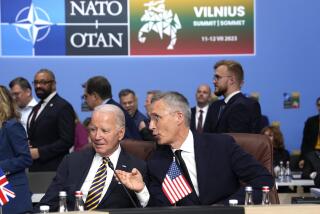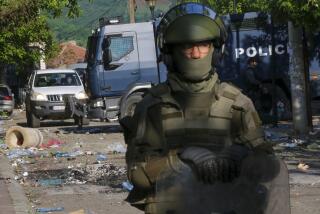Change Awakens Along With NATO : Military and political initiatives shake Balkans situation
Against the bloody backdrop of yet another horror in Bosnia, the Western powers have taken up the sword against the Serbian aggressors. Finally.
Dozens of NATO warplanes have pounded military targets in Pale, the Bosnian Serbs’ mountain capital, and in the hills around nearby Sarajevo, capital of the Muslim-dominated Bosnian government. Never before had NATO carried out such a large air attack. Never before could the main NATO players in Bosnia--the United States, France and Britain--agree on much of anything.
But in the last 48 hours, partly in response to the gruesome results of a Bosnian Serb artillery attack on a Sarajevo shopping district, convergent military and political initiatives have been loosed. With momentum, they could clear the hump of indecision that has blocked previous efforts to end the war in the Balkans, now 40 months old.
AN END TO DITHERING: The report that the initial NATO air attack, a night raid, accidentally killed five European Union observers at Pale did not deter the alliance from sending up a second wave in daylight. And, to the surprise of some, the NATO command showed no hesitation to strike again despite Russian demands that the fighting cease. This time the Bosnian Serbs had stepped across a line that was not to be ignored.
Long months of dithering and bickering had made NATO a holstered gun. The Serbs have taken comfort in that. Washington supported bombing from the outset, but NATO decisions are made in concurrence, and France and Britain, which unlike the United States had ground troops at risk in Bosnia, were cautious. Then Jacques Chirac, a hard-liner, became president of France and the equation changed, eventually tilting to the decision to strike.
In tandem with the military response, a U.S. peace initiative is under way, emotionally spurred by the deaths of three American peacemakers in a road accident earlier this month at Sarajevo. Richard Holbrooke, assistant secretary of state, held two days of talks in Paris with Alija Izetbegovic, the Bosnian president. The American then headed for Belgrade, capital of Yugoslavia, to discuss peace possibilities with President Slobodan Milosevic, whose Serb expansionist policies triggered the war and who now finds his country strangled by U.N. sanctions. Milosevic has lost some control over his Bosnian satrap, Radovan Karadzic, but still holds the purse that keeps the Serbian rebellion going in Bosnia.
SERBIAN SLIDE: The American plan remains under wraps but is said to be a deal that would turn over 49% of Bosnia, the eastern half, to Serbian control. The Bosnian Muslims and their Croatian allies would get the remaining 51%. Even that deal, which would give the Serbs half a country in reward for their aggression, is unacceptable to Karadzic, but recent military defeats and the forced emigration of the Serbian population in Croatia may temper his demands.
How the picture has changed since the Serbs began rolling up the United Nations’ so-called safe areas for Muslims earlier this year. That was the high point of Serbian success; it’s been downhill since.
Now the Serbian capital is under NATO attack. Never before in more than three years of warfare has that happened. Now the Americans are pushing a peace plan that may find acceptance in Belgrade. The big powers’ military and political strategies seem finally to be in sync.
The coming weeks will tell, but all the players--American, European, Muslim and Serb--should seize the opportunity. The moment is ripe. Enough.
More to Read
Sign up for Essential California
The most important California stories and recommendations in your inbox every morning.
You may occasionally receive promotional content from the Los Angeles Times.










